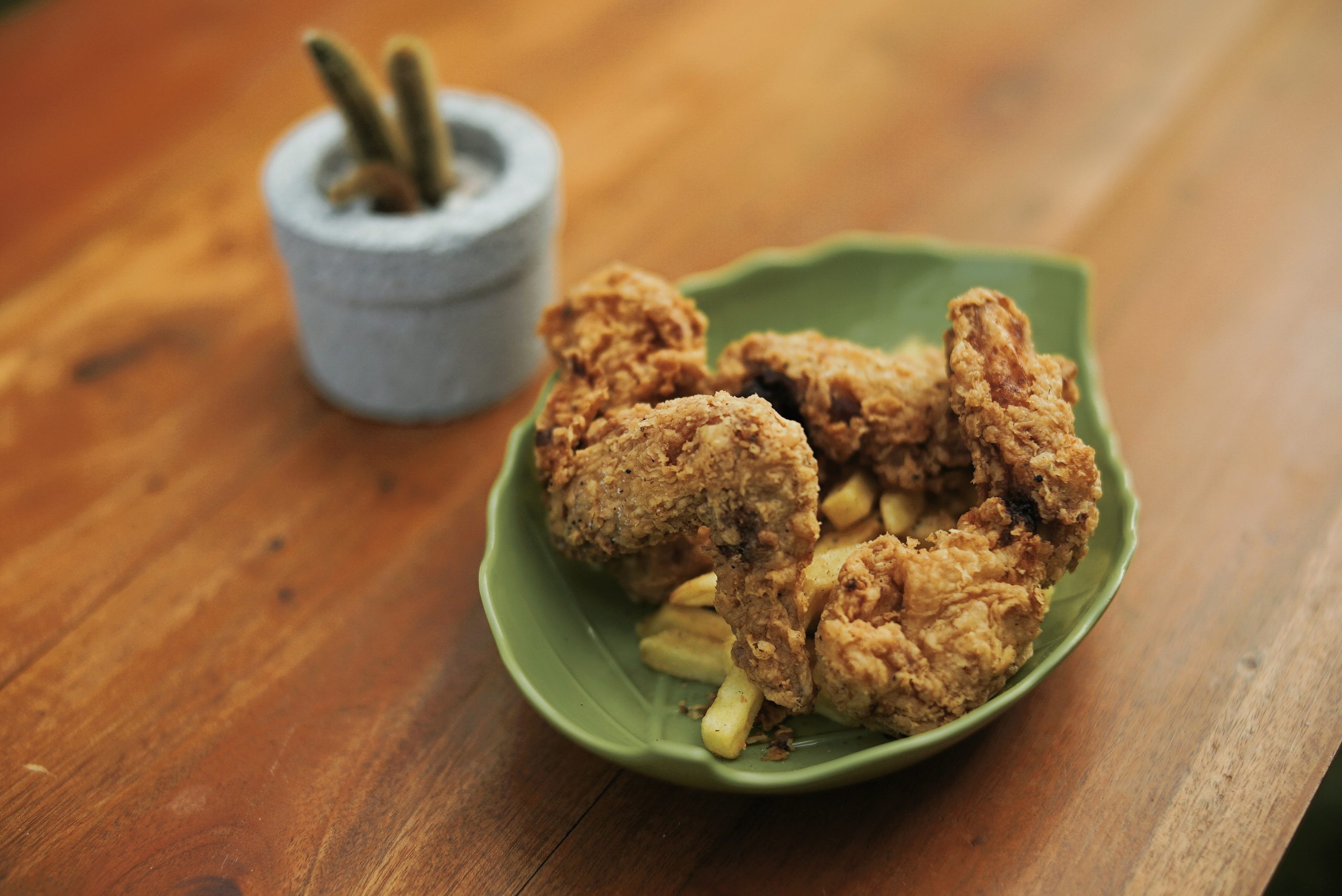You will hardly find someone who does not like perfectly crunchy and crispy fried chicken. Everyone sometimes craves for a few golden chicken wings, but not be tempted to go to the nearest fast food joint for once, make them home by yourself instead. You can easily customize the seasonings, choose your favorite part of the chicken and enjoy it fresh, hot, and without the crust getting soggy. With the help of a sous vide device, you do not have to be worried about your chicken to come out raw in the middle or overcooked and dry. You will always get a perfectly tender and moist interior with a golden brown crispy crust.
Ingredients (6-8 servings):
- 24 large chicken wings (or choose your favorite part of the chicken)
- 4 cups (1000 ml) of buttermilk
- 6 cups (750 g) of flour
- 2 cups (250 g) of corn starch
- 2 tablespoons (30 g) of kosher salt
- 2 tablespoons (30 g) of red tabasco or your favorite hot sauce
- 2 tablespoons (30 g) of paprika
- 1 tablespoon (15 g) of garlic power
- 1 tablespoon (15 g) of onion powder
- 1 tablespoon (15 g) of black pepper
- 1 teaspoon (5 g) of ground mustard seeds
- Canola/sunflower oil for frying
Steps:
- Selection of the Meat
- Getting Prepared for Cooking (Mise en Place)
- Cooking Sous Vide – Temperatures and Time
- Finishing the Meat and Serving Options
Step 1: Selection of the Meat
Chicken is one of the most popular types of meat across the world. You will hardly find any cuisine that does not carry at least one recipe using chicken. Therefore, sourcing your meat should be quite easy in comparison to other types like beef, fish, or seafood. You simply need to be aware of a few details that help you to choose correctly.
Parts of a Chicken
You can use any part of the chicken, depending on your preferences. The white meat (breasts) is lean, very soft and mild in flavor. Brown meat (legs, thighs, and wings) has more structure, more intense flavor, and does not dry out quickly. If you had bought a whole chicken and separated it into individual parts, the legs and the wings will likely be your pick for the frying. Other parts (thighs and breasts) are more commonly used in other recipes where you can let their natural flavor come through much more. However, if you are not a fan of the bone-in meat, no one will keep you from slicing the chicken breasts into thin strips and making some juicy chicken tenders. As it was said, there are nearly no limits when it comes to fried chicken.
Visual Appearance
There are different types of chicken on the market, all of which differ in appearance, flavor, and texture. The most significant difference you will surely spot is the color of the skin. Some chicken tends to be more white, while others may be more on the yellow side. One is not better than the other. The main difference here will be the way the chicken was fed and raised. The best tasting meat you get from free-range animals, which produce more flavorful and darker meat. The color of the fat and skin may then vary when a considerable amount of corn has been added to their diet. The skin should look dry. Make sure you don’t see any discoloration or pale brown spots on it. An excessive amount of liquid in the packaging is not a good sign either.
Freshness
The next factor to consider when selecting the meat is the freshness. The fresher, the better, so always look on the label. The meat should not be older then 2-3 days when buying, so it can last another day or two in your fridge before processing. It is contrary to beef, for instance, when the meat needs to be allowed aging to be more tender and flavorful.
Step 2: Getting Prepared for Cooking (Mise en Place)
This step is essential to get the perfect results because there are several things you can mess up without proper preparation. You will need two large bowls (the larger, the better), a sous vide device with a container, and a fryer filled with canola oil. You will also use a large cooling rack and tongs to handle the hot chicken conveniently. When everything is ready, you can proceed with your ingredients.
Cleaning the Wings
You may cook and eat the chicken wings as a whole, but to get all the pieces evenly cooked and optimally sized, it would be convenient to separate them into three parts. There are two joints on the wing, creating a kind of Z shape, where the pieces should be separated. Cut off the tip, which is composed of just bones and connective tissue, and is more suitable for adding to your stocks or soups. Then, try to find the center between drumette and wingette/flap by bending it back and forth to see where the joint is. You should be able to cut through the joint pretty effortlessly. If it feels that it needs more power, you are probably cutting the bone. Try to tilt or wiggle your knife, and the blade should find the right direction naturally.
Marinating the Chicken
The first step in achieving perfectly juicy and flavorful chicken is to marinate it for some time before cooking. Take a big bowl, pour in all of the buttermilk, and add your favorite hot sauce. You may consider adding half of the dry seasonings into the marinade to let the flavors penetrate the meat throughout. Some people leave the salt out of the marinade, but as long as you keep the concentration around 1 % – 2 %, it will not draw any moisture out and help to season the meat properly. For each cup (236 ml) of liquid, you need around 1/2 of a teaspoon (2.5 g) of salt. Place all your chicken pieces into the marinade and leave them for several hours (or even overnight) in your fridge.
Step 3: Cooking Sous Vide – Temperatures and Time
Take the chicken out of the bowl, let drip as much as possible of the marinade off. Set it aside for later use. Place the pieces into a sealable bag in one layer, seal it, and you have just been prepared for cooking. You can see the temperature to achieve the perfect results below. You may also use your sous vide application if your device manufacturer provided you with one.
155 °F (68 °C) for 2-3 hours
Step 4: Finishing the Meat and Serving Options
Prepare a large pot or fryer filled with canola or any other oil with a high smoking point and start heating it to 400 °F (204 °C). For safety reasons, do not fill the fryer up to the rim. Leave at least 1/3 reserve, so the oil will not overflow during the frying. It may even catch on fire when the hot oil gets directly in contact with a flame or extremely heated stove. It is always better to be safe than sorry.
In the meantime, you can prepare your chicken. Open the bag and drain all the liquid out. Place the wings on a paper towel and pat them dry all over. Mix the flour, corn starch, and the rest of the dry seasonings in a big bowl. Place your second bowl with all the remaining seasoned marinade next to it. To get your fried chicken extra crunchy, you may want to follow these two useful tips. First is to slowly drip few tablespoons of the marinade straight into the dry coating mixture and stir it well to create small lumps. Second is to double coat the chicken – at first, put it into the flour/starch, then into the buttermilk marinade, and then back again into the flour/starch mixture. This process makes your crust thicker, much crispier, and it will stick to chicken pieces better. It is also always good to use the biggest bowls you have so you can work with as much of the chicken as you can at once.
When the oil has reached the optimal temperature, and all the wings are coated, fry them for 3-4 minutes until they turn golden brown. Do not overcrowd the fryer or the pot with too many pieces at once, because the oil can easily overflow and cause you some big troubles. Also, remember that the meat has already been cooked, so your only intention is to achieve a crunchy crust. Use a slotted spoon or tongs for fishing the wings carefully out of the hot oil. Place your fried chicken on a cooling rack instead of a paper towel, so the crust does not get soggy.


